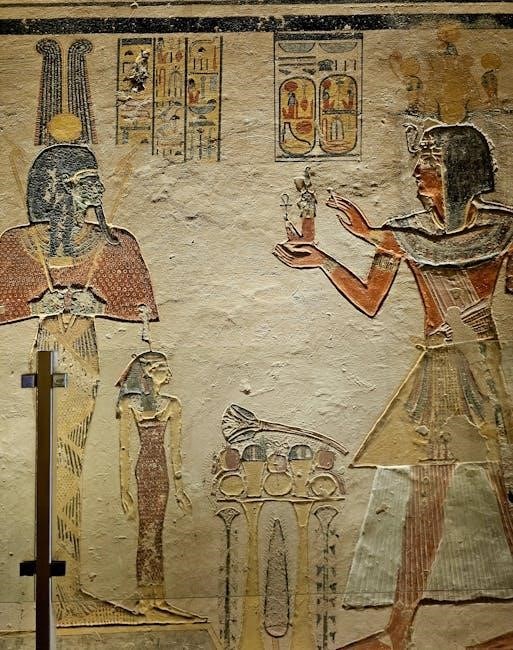A manual jack is a portable tool used to lift vehicles, enabling tire changes, repairs, and maintenance․ It combines simplicity and effectiveness for safe and efficient operation․
1․1 Definition and Purpose
A manual jack is a tool designed to lift vehicles by manually applying force, typically for maintenance or repairs․ It operates without electric power, relying on mechanical or hydraulic systems․ The primary purpose of a manual jack is to safely elevate a vehicle, allowing access to wheels, brakes, or suspension components․ It ensures stability and control during lifting, making it an essential tool for professionals and DIY enthusiasts alike․ Proper use of a manual jack enhances safety, efficiency, and precision in various automotive tasks․
1․2 Brief History of Manual Jacks
The origins of manual jacks date back to ancient civilizations, where simple lifting tools were used for construction and transportation․ Over time, these tools evolved, with the first screw jacks emerging in the Bronze Age․ By the Industrial Revolution, mechanical jacks became more sophisticated, incorporating hydraulic systems for greater efficiency․ The 20th century saw the development of portable, user-friendly designs, such as scissor and bottle jacks, which are widely used today․ Modern manual jacks combine durability, safety, and ease of use, making them indispensable in automotive and industrial settings․
1․3 Importance in Vehicle Maintenance
Manual jacks are indispensable tools in vehicle maintenance, providing essential lifting support for tasks like tire changes, inspections, and repairs․ Their portability and simplicity make them ideal for both professional and DIY use․ Manual jacks enable safe and efficient access to a vehicle’s underside, reducing the risk of damage to the frame or undercarriage․ Regular use of manual jacks ensures proper maintenance, extending the vehicle’s lifespan․ They are cost-effective and reliable, making them a cornerstone in every workshop or emergency kit, essential for maintaining vehicle integrity and safety․

Types of Manual Jacks
Manual jacks vary in design, including floor jacks, bottle jacks, scissor jacks, and hydraulic jacks, each offering unique features suited for different lifting needs and applications․
2․1 Floor Jacks
Floor jacks are designed for garage or workshop use, offering a low profile and long handle for easy maneuverability․ They are ideal for lifting cars and small trucks due to their durability and lifting capacity․ Typically made of steel, these jacks provide a stable and efficient way to raise vehicles, making them popular among professionals and DIY enthusiasts․ Their wide bases ensure stability, and their pumping mechanisms allow for quick lifting․ However, they are less portable than other types, making them best suited for stationary use․ Always use jack stands for added safety․
2․2 Bottle Jacks
Bottle jacks are compact, cylindrical tools designed for heavy-duty lifting․ Their versatility allows use at various angles, making them ideal for tight spaces and uneven surfaces․ Often used in industrial settings, they can handle significant weight, though their tall profile may require more space․ While durable and powerful, they are less common in personal garages due to their size and complexity․ Bottle jacks are favored for their strength and flexibility in professional environments, offering reliable performance for demanding tasks․ Always ensure proper alignment and stability for safe operation․
2․3 Scissor Jacks
Scissor jacks are lightweight, portable tools commonly included with vehicles for emergency tire changes․ Their compact design folds neatly for storage, often fitting in a car’s trunk․ Operating via a screw mechanism, they are easy to use but limited in lifting capacity and height․ Ideal for small vehicles and temporary use, scissor jacks provide essential support but should be supplemented with jack stands for added safety․ Their simplicity and convenience make them a standard accessory for drivers needing quick, reliable lifting solutions in unexpected situations․
2․4 Hydraulic Jacks
Hydraulic jacks use fluid pressure to lift vehicles, offering superior strength and efficiency․ They are commonly used in professional garages and for heavy-duty applications due to their high lifting capacity․ These jacks operate by pumping a handle to pressurize hydraulic fluid, which then powers a piston to raise the vehicle․ They are prized for their smooth, controlled lifting action and durability․ Regular maintenance, such as checking fluid levels and replacing seals, ensures optimal performance․ Hydraulic jacks are ideal for lifting heavy loads safely and efficiently, making them a valuable tool for both professionals and enthusiasts․

Key Components of a Manual Jack
A manual jack consists of a pumping system, hydraulic cylinder, base, and lifting arm, working together to provide stability and controlled lifting for vehicles and heavy objects․
3․1 Pumping System
The pumping system is the heart of a manual jack, converting manual effort into hydraulic pressure to lift heavy loads․ It typically includes a handle, pump, and fluid reservoir․ When the handle is pressed, it forces hydraulic fluid through the system, raising the lifting arm․ This mechanism ensures smooth and controlled lifting, making it essential for safe and efficient operation․ Regular maintenance, such as fluid checks and seal replacements, is crucial to maintain its performance and longevity․
3․2 Hydraulic Cylinder
The hydraulic cylinder is a critical component of a manual jack, responsible for converting hydraulic pressure into linear motion to lift vehicles․ It consists of a cylindrical tube, piston, and seals․ When hydraulic fluid is forced into the cylinder, the piston rises, extending the lifting arm․ The cylinder’s durability and precision engineering ensure stability and control during lifting․ Proper maintenance, including lubrication and seal inspection, is essential to prevent leaks and maintain optimal performance․ A well-functioning hydraulic cylinder is vital for the jack’s reliability and safety․
3․4 Base and Lifting Arm
The base of a manual jack provides stability and support, typically made of durable materials like steel for strength and balance․ The lifting arm, attached to the base, is designed to extend and lift the vehicle safely․ It connects to the hydraulic cylinder, transferring the force needed to raise the vehicle․ A sturdy base ensures the jack remains stable during operation, while the lifting arm’s precise engineering allows for controlled movement․ Regular inspection of these components is crucial to maintain reliability and safety, ensuring smooth operation and preventing accidents․ Proper alignment and maintenance are key to their longevity․

3․5 Safety Valve
The safety valve is a critical component of a manual jack, designed to prevent overloading and ensure safe operation․ It automatically releases pressure if the weight exceeds the jack’s capacity, protecting both the user and the vehicle from potential damage․ This mechanism also helps maintain control during lifting, preventing sudden drops․ Regular inspection of the safety valve is essential to ensure it functions correctly, providing an additional layer of security․ Its reliability is paramount for safe and efficient vehicle lifting, making it a vital feature in every manual jack design․

How to Use a Manual Jack Safely
Always position the jack on a stable, level surface and ensure the vehicle is secure․ Follow the manufacturer’s guidelines for weight limits and lifting procedures․
4․1 Preparing the Workspace
Before using a manual jack, ensure the workspace is safe and stable․ Choose a level, firm surface away from traffic․ Clear the area of obstacles and debris․ Engage the vehicle’s parking brake and place it in park or gear to prevent movement․ Use wheel chocks for added stability․ Refer to the vehicle’s manual for the correct jacking points․ Ensure proper lighting for visibility and wear protective gear․ Always have jack stands ready to secure the vehicle once lifted․ A well-prepared workspace minimizes risks and ensures a smooth lifting process․
4․2 Positioning the Jack
Positioning the jack correctly is crucial for safe and effective lifting․ Always consult the vehicle’s manual to locate the designated jacking points, typically marked with metal reinforcements․ Place the jack on a firm, level surface and align it with the jacking point․ For floor jacks, ensure the lifting arm is centered under the vehicle’s frame․ Slowly raise the jack until it contacts the lifting point, ensuring stability․ Avoid placing the jack on soft or uneven ground, as this can lead to instability or accidents․ Proper positioning ensures the vehicle is lifted safely and securely․ Always double-check the jack’s placement before lifting․
4․3 Raising the Vehicle
Raising the vehicle with a manual jack requires careful attention to ensure safety and stability․ Begin by slowly pumping the jack’s handle to lift the vehicle․ Maintain a steady pace, ensuring the jack remains vertical and centered under the lifting point․ Monitor the vehicle’s stability and stop immediately if any instability is detected․ Never exceed the jack’s weight capacity, as indicated in the manual․ Keep the lifting path clear of obstructions and ensure no one is underneath the vehicle during the process․ Raise the vehicle only until it is high enough to perform the necessary task, then secure it with jack stands for added safety․
4․4 Securing the Vehicle with Jack Stands
After raising the vehicle with a manual jack, securing it with jack stands is crucial for safety․ Place the stands on level ground and position them under the vehicle’s frame or axles, following the manufacturer’s guidelines․ Ensure the stands are rated for the vehicle’s weight and are stable before lowering the vehicle onto them․ Tighten the stands firmly and double-check their placement․ Never rely solely on the jack to support the vehicle during repairs․ Always refer to the vehicle’s manual for the correct lifting points to avoid damage or instability․

Maintenance and Repair of Manual Jacks
Regular lubrication of moving parts and checking hydraulic fluid levels are essential․ Replace worn seals and store the jack properly to ensure optimal performance and longevity․
5․1 Lubricating Moving Parts
Lubricating the moving parts of a manual jack is crucial for smooth operation and longevity․ Apply silicone-based grease to pivot points and joints regularly․ This prevents wear and corrosion, ensuring the jack functions effortlessly․ Neglecting lubrication can lead to stiff or seized parts, reducing efficiency․ Use a high-quality lubricant suitable for the jack’s materials to maintain optimal performance and prevent damage․ Regular lubrication also helps reduce friction, allowing the jack to lift and lower with minimal effort․ Always follow the manufacturer’s recommendations for the best results․
5․2 Checking Hydraulic Fluid Levels
Regularly checking the hydraulic fluid levels in your manual jack is essential for optimal performance․ Locate the fluid reservoir and ensure the level meets the manufacturer’s recommended mark․ If low, use the specified hydraulic fluid to refill․ Avoid overfilling, as this can cause leakage or damage․ Drain old fluid annually by placing the jack over a pan and removing the filler plug․ Refill with fresh fluid, then test the jack for proper function․ Always refer to the user manual for specific instructions and safety precautions during this process to maintain the jack’s efficiency and longevity․
5․3 Replacing Seals and O-Rings
Regular inspection and replacement of seals and O-rings in manual jacks are crucial to prevent fluid leakage and maintain hydraulic performance; Over time, these components can wear out or deteriorate, leading to reduced efficiency․ To replace them, gather the necessary tools and consult the user manual for specific instructions․ Remove the old seals and O-rings carefully, ensuring no residue remains․ Install new ones by hand or with a suitable tool, avoiding damage․ After replacement, test the jack by lifting a light load to check for leaks․ Properly functioning seals ensure reliable operation and safety during use․
5․4 Storing the Jack Properly
Proper storage of a manual jack is essential to maintain its functionality and longevity․ After use, clean the jack thoroughly to remove dirt or debris․ Inspect for damage and ensure all parts are in good condition․ Store the jack in a dry, cool place, away from direct sunlight and chemicals․ Use a protective cover to prevent rust and dust accumulation․ Avoid leaving the jack in a horizontal position, as this may cause hydraulic fluid leakage․ Always store it on a stable, flat surface, and consider securing it to prevent accidental movement․ Proper storage ensures the jack remains ready for future use․

Safety Guidelines for Manual Jacks
Always use jack stands, check weight limits, ensure stability on level ground, avoid overloading, and wear protective gear to ensure safe and secure vehicle lifting operations․
6․1 Weight Capacity and Limits
Understanding the weight capacity of your manual jack is crucial for safe operation․ Always check the maximum load rating specified in the user manual to avoid overloading․ Exceeding this limit can lead to jack failure, potentially causing accidents․ Ensure the vehicle’s weight matches the jack’s capacity, and never use a jack beyond its rated limit․ This precaution is essential to maintain stability and prevent damage to both the jack and the vehicle during lifting․
6․2 Ensuring Stability on Level Ground
Ensuring your manual jack is used on level ground is critical for stability and safety․ Always check the surface for firmness and evenness before positioning the jack․ Avoid soft, uneven, or loose surfaces, as they can cause the jack to slip or tip․ If necessary, use sturdy wooden planks or jack stands to create a stable base․ Position the jack squarely under the vehicle’s lift points, as indicated in the user manual․ Tighten all locks or brakes to secure the jack in place, ensuring the vehicle remains balanced during lifting․
6․3 Avoiding Overloading
Avoiding overloading is essential to ensure the safe operation of a manual jack․ Always check the weight capacity specified in the user manual and never exceed it; Exceeding the limit can lead to structural failure, accidents, or personal injury․ Ensure the vehicle is positioned correctly on level ground and use jack stands for added support․ If unsure about the weight or capacity, consult the vehicle’s manual or seek professional assistance․ Never rely solely on the jack for extended periods; always secure the vehicle with stands after lifting․
6․4 Wearing Protective Gear
Wearing protective gear is crucial when using a manual jack to ensure personal safety․ Always wear safety glasses to protect your eyes from debris or fluid leakage․ Gloves provide a secure grip and prevent skin abrasions․ Steel-toe boots are recommended to safeguard feet from heavy tools or falling objects․ Additionally, high-visibility clothing can enhance awareness in low-light conditions․ These precautions minimize risks and ensure a safe working environment․ Always refer to the user manual for specific safety recommendations tailored to your jack model and usage scenario․

Troubleshooting Common Issues
Identify and address common problems like fluid leaks, slow lifting, or stuck parts․ Regular maintenance and inspection help resolve issues promptly for optimal performance and safety․
7․1 Jack Not Lifting Properly
If a manual jack fails to lift properly, check for low hydraulic fluid levels or leaks in the system․ Ensure the jack is positioned on a level, sturdy surface․ Inspect for worn seals or damaged parts, as these can reduce lifting efficiency․ Refer to the user manual for specific instructions on fluid replacement and maintenance․ Additionally, verify that the jack is not overloaded, as exceeding weight limits can impair functionality․ Regular lubrication of moving parts and proper storage can also prevent such issues․ Always address problems promptly to maintain safety and effectiveness․
7․2 Hydraulic Fluid Leakage
Hydraulic fluid leakage in a manual jack can lead to reduced lifting capacity and eventual failure․ Inspect the jack for visible cracks, worn seals, or loose connections․ Tighten any loose fittings and replace damaged seals or O-rings․ Clean the jack thoroughly to prevent debris from exacerbating the issue․ If leakage persists, consult the user manual for guidance on disassembling and repairing the hydraulic system․ Regular maintenance, such as checking fluid levels and replacing worn parts, can prevent leaks․ Always use the recommended hydraulic fluid to ensure optimal performance and longevity of the jack․
7․3 Slow or Stuck Movement
Slow or stuck movement in a manual jack often results from insufficient lubrication or debris buildup․ Regularly clean the piston and lifting arm, and apply a high-quality grease to moving parts․ Check the hydraulic fluid level and ensure it meets the manufacturer’s recommendations․ If the issue persists, inspect for worn or damaged seals, which may require replacement․ Avoid using excessive force, as this can damage internal components․ Proper maintenance and timely repairs can restore smooth operation and extend the jack’s lifespan․ Always refer to the user manual for specific guidance on troubleshooting and maintenance procedures․
7․4 Damaged or Worn Parts
Damaged or worn parts in a manual jack can lead to reduced performance or complete failure․ Common issues include a leaking hydraulic cylinder, a bent lifting arm, or worn-out seals․ Inspect the jack regularly for signs of wear, such as hydraulic fluid leakage or metal shavings․ Replace damaged components promptly to ensure safety and functionality․ If the piston or pump is damaged, consider consulting a professional or replacing the jack entirely․ Always follow the manufacturer’s guidelines for repairs and replacements to maintain optimal performance and prevent further damage․ Regular maintenance can extend the lifespan of your manual jack․

Accessories for Manual Jacks
Accessories like jack stands, wheel chocks, and hydraulic fluid enhance safety and functionality․ Carrying cases provide portability, while additional tools ensure proper maintenance and operation of the jack․
8․1 Jack Stands
Jack stands are essential safety tools used alongside manual jacks․ They provide stable support for vehicles, preventing sudden drops․ Available in various heights and weight capacities, they ensure safety during repairs․ Durable materials like steel or aluminum are common․ Always place them on level ground and check for stability before use․ Regular maintenance, such as lubricating moving parts, extends their lifespan․ Using jack stands is crucial for protecting both the vehicle and the person working underneath it․
8․2 Wheel Chocks
Wheel chocks are essential safety accessories used to prevent vehicles from rolling during maintenance․ Made from durable materials like rubber or plastic, they are placed in front of and behind the wheels․ This ensures stability and safety when working under a raised vehicle․ Wheel chocks are particularly useful on inclines or uneven surfaces․ They complement jack stands by adding an extra layer of security, preventing accidental movement․ Always place them on level ground for maximum effectiveness․ Regularly inspect them for damage to maintain their reliability and ensure safe vehicle maintenance practices․
8․3 Hydraulic Fluid
Hydraulic fluid is a crucial component for manual jacks, ensuring smooth operation by lubricating moving parts and maintaining pressure․ Regular maintenance requires changing the fluid annually to prevent contamination and degradation․ The procedure involves draining the old fluid into a pan and refilling with the recommended type․ Proper fluid levels are essential for optimal performance․ Always refer to the user manual for specific guidelines․ Using the wrong fluid can lead to corrosion or malfunction․ Regular checks and maintenance ensure the jack operates safely and efficiently, extending its lifespan and reliability during vehicle lifting tasks․
8․4 Carrying Cases
Carrying cases are essential accessories for manual jacks, providing protection during transport and storage․ Durable materials like heavy-duty nylon or plastic ensure longevity․ Many cases feature padded interiors and multiple compartments for organizing accessories like hydraulic fluid and extra seals․ A well-designed case prevents damage to the jack and keeps tools tidy․ It also enhances portability, making it easier to carry the jack to different locations․ Investing in a high-quality carrying case extends the jack’s lifespan and ensures it remains in optimal condition for future use․

Comparison with Other Lifting Tools
Manual jacks are compared with electric jacks, air lifts, and bottle jacks for efficiency, cost, and usage․ Each tool offers unique advantages for specific tasks and preferences․
9․1 Manual vs․ Electric Jacks
Manual and electric jacks differ significantly in operation and convenience․ Manual jacks require physical effort, relying on hydraulics or mechanical advantage, whereas electric jacks are powered by motors, offering faster lifting with minimal effort․ Electric jacks are more convenient for frequent use but may lack portability and depend on power sources․ Manual jacks are cost-effective, durable, and ideal for occasional use, making them a popular choice for basic vehicle maintenance․ Each type suits different needs, with manual jacks excelling in simplicity and reliability․
9․2 Floor Jacks vs․ Bottle Jacks
Floor jacks and bottle jacks differ in design and functionality․ Floor jacks are designed for flat surfaces, offering stability and ease of use, while bottle jacks are compact and versatile, usable at various angles․ Floor jacks often have longer handles for better leverage, making them ideal for heavy vehicles․ Bottle jacks, however, are lightweight and portable, suitable for tight spaces․ Both are effective but cater to different needs, with floor jacks excelling in professional settings and bottle jacks preferred for versatility and convenience in diverse scenarios․
9․3 Jacks vs․ Air Lifts
Manual jacks and air lifts serve similar purposes but differ in functionality․ Jacks are manual tools requiring physical effort to lift vehicles, while air lifts use compressed air for easier, faster lifting․ Air lifts are typically used in professional settings for heavy-duty applications, offering smoother operation and less strain․ Jacks, however, are more affordable, portable, and suitable for basic maintenance․ Air lifts are preferred for frequent use and larger loads, while jacks remain ideal for occasional, lightweight tasks․ Both tools have distinct advantages, catering to different user needs and preferences․
9․4 Cost and Efficiency
Manual jacks are often more affordable than powered alternatives, making them a cost-effective solution for vehicle owners․ Their efficiency lies in simplicity, requiring minimal maintenance and no external power sources․ While they may demand more physical effort, their reliability in emergencies and straightforward design make them a practical choice․ For basic lifting tasks, manual jacks offer excellent value, balancing cost and performance effectively․ They remain a preferred option for many due to their accessibility and ease of use, ensuring efficiency in everyday applications without compromising on functionality․
Manual jacks are essential tools for vehicle maintenance, offering reliability and simplicity․ Proper usage ensures safety and efficiency, making them indispensable for car owners and professionals alike․
10․1 Summary of Key Points
Manual jacks are indispensable tools for vehicle maintenance, offering reliability and ease of use․ They come in various types, such as floor, bottle, scissor, and hydraulic jacks, each suited for specific tasks․ Proper usage involves preparing the workspace, positioning the jack correctly, and securing the vehicle with jack stands․ Regular maintenance, including lubrication and fluid checks, ensures optimal performance․ Understanding safety guidelines, like weight limits and stability, is crucial to prevent accidents․ Troubleshooting common issues, such as fluid leaks or slow movement, helps maintain functionality․ By following these practices, users can ensure safe and efficient lifting operations․
10․2 Final Tips for Users
Always refer to your vehicle’s manual for specific jack usage guidelines․ Ensure the jack is placed on a level, stable surface and never exceed its weight capacity․ Regularly inspect and maintain the jack to prevent wear and tear․ Use jack stands for added safety when working under a lifted vehicle․ Keep the jack clean and store it in a dry place to avoid corrosion․ Practice lifting techniques to build confidence and efficiency․ Never rely solely on the jack—always prioritize caution and safety during any lifting operation․
10․3 Importance of Proper Usage
Proper usage of a manual jack is crucial for safety and effectiveness․ It prevents accidents, ensures the jack’s longevity, and maintains vehicle stability during lifting․ Always follow the manufacturer’s guidelines and adhere to weight limits to avoid damage or collapse․ Correct techniques prevent personal injury and mechanical damage․ Regular maintenance, like lubricating parts and checking fluid levels, ensures reliable performance․ Proper usage also avoids costly repairs and extends the jack’s service life․ Prioritizing safe practices guarantees a secure working environment and protects both the user and the vehicle․


















































